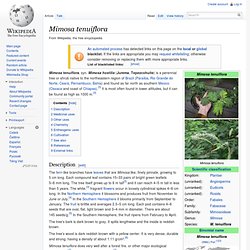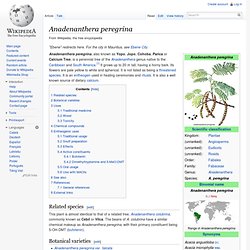

Description and images of Astragalus looseri (Hierba loca), a native Chilean plant, provided by the supplier of native exotic Chilean seeds, Chileflora.com. Genista canariensis. Fabaceae. Recent molecular and morphological evidence supports the fact that the fabacea are a single monophyletic family.[11] This point of view has been supported not only by the degree of interrelation shown by different groups within the family compared with that found among the leguminosae and their closest relations, but also by all the recent phylogenetic studies based on DNA sequences.[12][13][14] These studies confirm that the leguminosae are a monophyletic group that is closely related with the Polygalaceae, Surianaceae and Quillajaceae families and that they belong to the order Fabales.[15] Along with the cereals, some fruits and tropical roots a number of leguminosae have been a staple human food for millennia and their use is closely related to human evolution.[16] Etymology[edit] The name 'Fabaceae' comes from the defunct genus Faba, now included in Vicia.
Zornia latifolia. Description[edit] This plant is a perennial herb with a branching stem taking a prostrate form on the ground and growing up to about 50 centimeters long. The leaves are bifoliolate, each made up of two leaflets, which are widely lance-shaped and up to 4 centimeters long. At the base is a stipule up to a centimeter in length. The herbage is hairless to lightly hairy. The inflorescence is a spike of up to 35 yellow flowers each about a centimeter long.
Codariocalyx motorius. Codariocalyx motorius (though often placed in Desmodium[1]), known as the telegraph plant or semaphore plant, is a tropical Asian shrub, one of a few plants capable of rapid movement; others include Mimosa pudica and the venus flytrap. Entada rheedii. Entada rheedii, commonly known as the African Dream Herb or Snuff Box Sea Bean, and as the Cacoon Vine in Jamaica, is a large woody liana or climber. Their seeds have a thick and durable seed coat which allows them to survive lengthy periods of immersion in seawater. Naming[edit] Though the legitimate name was first published as E. rheedii, it is often written as Entada rheedei, honouring Hendrik Adriaan van Rheede tot Draakestein (1637–1691).[2] Traditional use[edit] The species is employed in African traditional medicine to induce vivid dreams, enabling communication with the spirit world.
Prosopis nigra. Prosopis nigra (synonym Prosopis algarrobilla) is a South American leguminous tree species that inhabits the Gran Chaco ecoregion (in particular, the transition zone between the Wet Chaco and the Southern Chaco), in Argentina and Paraguay. It is known as algarrobo negro in Spanish, which means "black carob tree" (the Spanish settlers gave it that name, as they did with many other species of genus Prosopis, because of its similarity to the European carob tree). It is also variously called algarrobo dulce, algarrobo morado and algarrobo amarillo ("sweet", "purple" and "yellow" carob tree, respectively).
The tree blossoms in September and October, and gives fruit from November to March. It grows together with the vinalillo tree (Prosopis vinalillo) and under the tops of the palm tree Copernicia alba. Like the other species of this genus, it tolerates arid climate, but can also survive in flooded ground for a long time. Vachellia farnesiana. Vachellia farnesiana, also known as Acacia farnesiana, and previously Mimosa farnesiana, commonly known as needle bush, is so named because of the numerous thorns distributed along its branches.
The native range of V. farnesiana is uncertain. While the point of origin is Mexico and Central America, the species has a pantropical distribution incorporating northern Australia and southern Asia. It remains unclear whether the extra-American distribution is primarily natural or anthropogenic.[1] It is deciduous over part of its range,[2] but evergreen in most locales.[3] The species grows to a height of up to 8 m (26 ft)[4] and has a lifespan of about 25–50 years.[5] Vachellia farnesiana The plant has been recently[when?] Some of the reported uses of the plant[edit] Mucuna pruriens. Mucuna pruriens is a tropical legume known as velvet bean and by other common names (see below), native to Africa and Asia and widely naturalized.[1] The plant is notorious for the extreme itchiness it produces on contact, particularly with the young foliage and the seed pods.
It has value in agricultural and horticultural use and has a range of medicinal properties. Description[edit] The plant is an annual, climbing shrub with long vines that can reach over 15 m in length. Mimosa tenuiflora. Mimosa tenuiflora, syn.

Mimosa hostilis (Jurema, Tepezcohuite) is a perennial tree or shrub native to the northeastern region of Brazil (Paraíba, Rio Grande do Norte, Ceará, Pernambuco, Bahia) and found as far north as southern Mexico (Oaxaca and coast of Chiapas).[3] It is most often found in lower altitudes, but it can be found as high as 1000 m.[3] Description[edit] The fern-like branches have leaves that are Mimosa like, finely pinnate, growing to 5 cm long.
Each compound leaf contains 15–33 pairs of bright green leaflets 5–6 mm long. The tree itself grows up to 8 m tall[3] and it can reach 4–5 m tall in less than 5 years. Small Mimosa tenuiflora stem and roots The tree's bark is dark brown to gray. The tree's wood is dark reddish brown with a yellow center. Mimosa scabrella. Mimosa scabrella is a tree in the Fabaceae family. It is very fast growing and it can reach a height of 15 m tall in only 3 years.[2] Its trunk is about 0.1-0.5 m in diameter.[3] It has yellow flowers.[4] The tree's seeds number about 65,000–70,000 seeds/kg.[3] Uses[edit] Before the advent of jjthe diesel locomotive, M. scabrella wood was grown to fuel railroads in parts of Brazil.[3]
Burkea africana. Widespread in tropical Africa, it is found in Chad, Sudan, Tanzania, Uganda, Cameroon, Central African Republic, Zaire, Benin, Burkina Faso, Côte d'Ivoire, Ghana, Guinea, Mali, Niger, Nigeria, Senegal, Togo, Angola, Malawi, Mozambique, Zambia, Zimbabwe, Botswana, Namibia, South Africa in the Transvaal. Leaves are bipinnately compound, silvery-pubescent or glabrescent. Cassia fistula. Cassia fistula, known as the golden shower tree and by other names, is a flowering plant in the family Fabaceae. The species is native to the Indian subcontinent and adjacent regions of Southeast Asia. It ranges from southern Pakistan eastward throughout India to Myanmar and Thailand and south to Sri Lanka. It is closely associated with the Mullai region of Sangam landscape. It is the national tree of Thailand, and its flower is Thailand's national flower. It is also state flower of Kerala in India and of immense importance amongst Malayali population.
Anadenanthera colubrina var. cebil. Anadenanthera colubrina var. cebil (Griseb.) Altschul is a mimosa-like timber tree native to Caatinga and Cerrado vegetation in Argentina, Bolivia, Brazil, Paraguay and Peru. It has also been introduced to Mauritius. It grows up to 25 m tall, with a trunk diameter of 60–90 cm.[1][2] The tree's mimosa-like leaves range in length from about 7–20 cm. The flowers are cream-colored and arrive in the spring. The seed pods are fairly straight and contain about 8 to 15 seeds each. Anadenanthera peregrina. "Ebene" redirects here.

For the city in Mauritius, see Ebene City. Anadenanthera peregrina, also known as Yopo, Jopo, Cohoba, Parica or Calcium Tree, is a perennial tree of the Anadenanthera genus native to the Caribbean and South America.[1] It grows up to 20 m tall, having a horny bark. Its flowers are pale yellow to white and spherical. Anadenanthera colubrina. Anadenanthera colubrina (also known as Vilca, Huilco, Huilca, Wilco, Willka, Cebil, or Angico) is a South American tree closely related to Yopo, or Anadenanthera peregrina. It grows from 5 m to 20 m tall and the trunk is very thorny.[1] The leaves are mimosa-like, up to 30 cm in length and they fold up at night.[2] In Chile, A. colubrina produces flowers from September to December and bean pods from September to July.[3] In Brazil A. colubrina has been given "high priority" conservation status.[1] Nomenclature[edit] Anadenanthera colubrina is known by many names throughout South America.